Monitoring Bark Beetle Forest Damage in Central Europe. A Remote Sensing Approach Validated with Field Data
Abstract
1. Introduction
2. Study Area and Data
2.1. Study Area
2.2. Sentinel-2 Satellite Images
2.3. Ground Truth Data
3. Methods
3.1. Forest/Non-Forest Classification
3.2. Species Identification
3.3. Anomaly Detection and Damage Detection
3.4. Ground Truth Data and Validation
4. Results
4.1. Bark Beetle Damage Maps
4.2. Validation Results
5. Discussion
6. Conclusions
Author Contributions
Funding
Conflicts of Interest
References
- Forest Managent Institute of the Czech Republic. Information on the State of Forests from the Comprehensive Forest Management Plans for 2019. Available online: http://www.uhul.cz/ke-stazeni/informace-o-lese/slhp (accessed on 26 October 2020).
- Zahradník, P.; Zahradníková, M. Salvage felling in the Czech Republic‘s forests during the last twenty years. Cent. Eur. For. J. 2019, 65, 12–20. [Google Scholar] [CrossRef]
- Czech Statistical Office. Reports of Czech Republic Statistical Office from Forestry Sector. Available online: https://www.czso.cz/csu/czso/forestry-2019 (accessed on 28 August 2020).
- Ebner, G. Up to 60 million m3 of Bark Beetle Damage This Year. Available online: https://www.timber-online.net/rundholz/2020/02/up-to-60-million-m--of-bark-beetle-damage-this-year.html (accessed on 24 August 2020).
- Lausch, A.; Heurich, M.; Gordalla, D.; Dobner, H.-J.; Gwillym-Margianto, S.; Salbach, C. Forecasting potential bark beetle outbreaks based on spruce forest vitality using hyperspectral remote-sensing techniques at different scales. For. Ecol. Manag. 2013, 308, 76–89. [Google Scholar] [CrossRef]
- Schlyter, F.; Birgersson, G.; Byers, J.A.; Löfqvist, J.; Bergström, G. Field response of spruce bark beetle, Ips typographus, to aggregation pheromone candidates. J. Chem. Ecol. 1987, 13, 701–716. [Google Scholar] [CrossRef] [PubMed]
- Biedermann, P.H.W.; Müller, J.; Grégoire, J.-C.; Gruppe, A.; Hagge, J.; Hammerbacher, A.; Hofstetter, R.W.; Kandasamy, D.; Kolarik, M.; Kostovcik, M.; et al. Bark Beetle Population Dynamics in the Anthropocene: Challenges and Solutions. Trends Ecol. Evol. 2019, 34, 914–924. [Google Scholar] [CrossRef]
- Trumbore, S.; Brando, P.; Hartmann, H. Forest health and global change. Science 2015, 349, 814–818. [Google Scholar] [CrossRef]
- Jönsson, A.M.; Appelberg, G.; Harding, S.; Bärring, L. Spatio-temporal impact of climate change on the activity and voltinism of the spruce bark beetle, Ips typographus. Glob. Chang. Biol. 2009, 15, 486–499. [Google Scholar] [CrossRef]
- Seidl, R.; Rammer, W.; Jäger, D.; Lexer, M.J. Impact of bark beetle (Ips typographus L.) disturbance on timber production and carbon sequestration in different management strategies under climate change. For. Ecol. Manag. 2008, 256, 209–220. [Google Scholar] [CrossRef]
- Seidl, R.; Rammer, W. Climate change amplifies the interactions between wind and bark beetle disturbances in forest landscapes. Landsc. Ecol. 2017, 32, 1485–1498. [Google Scholar] [CrossRef]
- Wermelinger, B. Ecology and management of the spruce bark beetle Ips typographus—A review of recent research. For. Ecol. Manag. 2004, 202, 67–82. [Google Scholar] [CrossRef]
- Krejzar, T. Bark Beetle Outbreak in the Czech Republic: Challenges and Solutions. European Network INTEGRATE Seminar on Managing bark Beetle Impacts on Forests. Białowieża, Poland. 2018. Available online: https://informar.eu/sites/default/files/pdf/Presentation%20CZ%20062018.pdf (accessed on 7 October 2020).
- Stereńczak, K.; Mielcarek, M.; Kamińska, A.; Kraszewski, B.; Piasecka, Ż.; Miścicki, S.; Heurich, M. Influence of selected habitat and stand factors on bark beetle Ips typographus (L.) outbreak in the Białowieża Forest. For. Ecol. Manag. 2020, 459, 117826. [Google Scholar] [CrossRef]
- Hall, R.J.; Castilla, G.; White, J.C.; Cooke, B.J.; Skakun, R.S. Remote sensing of forest pest damage: A review and lessons learned from a Canadian perspective. Can. Entomol. 2016, 148, S296–S356. [Google Scholar] [CrossRef]
- Wulder, M.A.; Dymond, C.C.; White, J.C.; Leckie, D.G.; Carroll, A.L. Surveying mountain pine beetle damage of forests: A review of remote sensing opportunities. For. Ecol. Manag. 2006, 221, 27–41. [Google Scholar] [CrossRef]
- Hollaus, M.; Vreugdenhil, M. Radar Satellite Imagery for Detecting Bark Beetle Outbreaks in Forests. Curr. For. Rep. 2019, 5, 240–250. [Google Scholar] [CrossRef]
- Abdullah, H.; Darvishzadeh, R.; Skidmore, A.K.; Groen, T.A.; Heurich, M. European spruce bark beetle (Ips typographus, L.) green attack affects foliar reflectance and biochemical properties. Int. J. Appl. Earth Obs. Geoinf. 2018, 64, 199–209. [Google Scholar] [CrossRef]
- Coops, N.C.; Waring, R.H.; Wulder, M.A.; White, J.C. Prediction and assessment of bark beetle-induced mortality of lodgepole pine using estimates of stand vigor derived from remotely sensed data. Remote Sens. Environ. 2009, 113, 1058–1066. [Google Scholar] [CrossRef]
- Meddens, A.J.H.; Hicke, J.A.; Vierling, L.A.; Hudak, A.T. Evaluating methods to detect bark beetle-caused tree mortality using single-date and multi-date Landsat imagery. Remote Sens. Environ. 2013, 132, 49–58. [Google Scholar] [CrossRef]
- Meigs, G.W.; Kennedy, R.E.; Cohen, W.B. A Landsat time series approach to characterize bark beetle and defoliator impacts on tree mortality and surface fuels in conifer forests. Remote Sens. Environ. 2011, 115, 3707–3718. [Google Scholar] [CrossRef]
- Abdullah, H.; Skidmore, A.K.; Darvishzadeh, R.; Heurich, M. Sentinel-2 accurately maps green-attack stage of European spruce bark beetle (Ips typographus, L.) compared with Landsat-8. Remote Sens. Ecol. Conserv. 2019, 5, 87–106. [Google Scholar] [CrossRef]
- Zimmermann, S.; Hoffmann, K. Evaluating the capabilities of Sentinel-2 data for large-area detection of bark beetle infestation in the Central German Uplands. J. Appl. Remote Sens. 2020, 14, 024515. [Google Scholar] [CrossRef]
- Safonova, A.; Tabik, S.; Alcaraz-Segura, D.; Rubtsov, A.; Maglinets, Y.; Herrera, F. Detection of Fir Trees (Abies sibirica) Damaged by the Bark Beetle in Unmanned Aerial Vehicle Images with Deep Learning. Remote Sens. 2019, 11, 643. [Google Scholar] [CrossRef]
- Klouček, T.; Komárek, J.; Surový, P.; Hrach, K.; Janata, P.; Vašíček, B. The use of UAV mounted sensors for precise detection of bark beetle infestation. Remote Sens. 2019, 11, 1561. [Google Scholar] [CrossRef]
- Näsi, R.; Honkavaara, E.; Blomqvist, M.; Lyytikäinen-Saarenmaa, P.; Hakala, T.; Viljanen, N.; Kantola, T.; Holopainen, M. Remote sensing of bark beetle damage in urban forests at individual tree level using a novel hyperspectral camera from UAV and aircraft. Urban For. Urban Green. 2018, 30, 72–83. [Google Scholar] [CrossRef]
- Näsi, R.; Honkavaara, E.; Lyytikäinen-Saarenmaa, P.; Blomqvist, M.; Litkey, P.; Hakala, T.; Viljanen, N.; Kantola, T.; Tanhuanpää, T.; Holopainen, M. Using UAV-based photogrammetry and hyperspectral imaging for mapping bark beetle damage at tree-level. Remote Sens. 2015, 7, 15467–15493. [Google Scholar] [CrossRef]
- Fassnacht, F.E.; Latifi, H.; Ghosh, A.; Joshi, P.K.; Koch, B. Assessing the potential of hyperspectral imagery to map bark beetle-induced tree mortality. Remote Sens. Environ. 2014, 140, 533–548. [Google Scholar] [CrossRef]
- Honkavaara, E.; Näsi, R.; Oliveira, R.; Viljanen, N.; Suomalainen, J.; Khoramshahi, E.; Hakala, T.; Nevalainen, O.; Markelin, L.; Vuorinen, M.; et al. Using multitemporal hyper-and multispectral UAV imaging for detecting bark beetle infestation on norway spruce. Int. Arch. Photogramm. Remote Sens. Spat. Inf. Sci. ISPRS Arch. 2020, 43, 429–434. [Google Scholar] [CrossRef]
- Tanase, M.A.; Aponte, C.; Mermoz, S.; Bouvet, A.; Le Toan, T.; Heurich, M. Detection of windthrows and insect outbreaks by L-band SAR: A case study in the Bavarian Forest National Park. Remote Sens. Environ. 2018, 209, 700–711. [Google Scholar] [CrossRef]
- Ministry of Agriculture of the Czech Republic. Information on Forests and Forestry in the Czech Republic by 2019. Available online: http://eagri.cz/public/web/file/658587/Zprava_o_stavu_lesa_2019.pdf (accessed on 7 October 2020).
- Lukeš, P.; Strejček, R.; Křístek, Š.; Mlčoušek, M. Forest Health Assessment in Czech Republic Using Sentinel-2 Satellite Data. Certified Methodology; Forest Management Institute: Brandýs nad Labem, Czech Republic, 2018; ISBN 978-80-88184-21-8. [Google Scholar]
- Barka, I.; Lukeš, P.; Bucha, T.; Hlásny, T.; Strejček, R.; Mlčoušek, M.; Křístek, Š. Remote sensing-based forest health monitoring systems—Case studies from Czechia and Slovakia. Cent. Eur. For. J. 2018, 64, 259–275. [Google Scholar] [CrossRef]
- De Ocampo, A.L.P.; Bandala, A.A.; Dadios, E.P. Estimation of Triangular Greenness Index for Unknown PeakWavelength Sensitivity of CMOS-acquired Crop Images. In Proceedings of the 2019 IEEE 11th International Conference on Humanoid, Nanotechnology, Information Technology, Communication and Control, Environment, and Management (HNICEM), Laoag, Philippines, 29 November–1 December 2019; pp. 1–5. [Google Scholar]
- Minařík, R.; Langhammer, J. Use of a multispectral UAV photogrammetry for detection and tracking of forest disturbance dynamics. Int. Arch. Photogramm. Remote Sens. Spat. Inf. Sci. 2016, XLI-B8, 711–718. [Google Scholar] [CrossRef]
- Brovkina, O.; Cienciala, E.; Surový, P.; Janata, P. Unmanned aerial vehicles (UAV) for assessment of qualitative classification of Norway spruce in temperate forest stands. Geo-Spat. Inf. Sci. 2018, 21, 12–20. [Google Scholar] [CrossRef]
- Balková, M.; Bajer, A.; Patočka, Z.; Mikita, T. Visual Exposure of Rock Outcrops in the Context of a Forest Disease Outbreak Simulation Based on a Canopy Height Model and Spectral Information Acquired by an Unmanned Aerial Vehicle. ISPRS Int. J. Geo-Inf. 2020, 9, 325. [Google Scholar] [CrossRef]
- Czech Hydrometeorological Institute. Territorial Air Temperature. Available online: http://portal.chmi.cz/historicka-data/pocasi/uzemni-teploty?l=en (accessed on 7 October 2020).
- Czech Hydrometeorological Institute. Territorial Precipitation. Available online: http://portal.chmi.cz/historicka-data/pocasi/uzemni-srazky?l=en (accessed on 7 October 2020).
- European Space Agency. Sentinel-2 Level-2A Algorithm Theoretical Basis Document; European Space Agency: Paris, France, 2020. [Google Scholar]
- Fernandez-Carrillo, A.; de la Fuente, D.; Rivas-Gonzalez, F.W.; Franco-Nieto, A. A Sentinel-2 unsupervised forest mask for European sites. Proc. SPIE 2019, 11156, 111560Y. [Google Scholar]
- Fernandez-Carrillo, A.; Franco-Nieto, A.; Pinto-Bañuls, E.; Basarte-Mena, M.; Revilla-Romero, B. Designing a Validation Protocol for Remote Sensing Based Operational Forest Masks Applications. Comparison of Products Across Europe. Remote Sens. 2020, 12, 3159. [Google Scholar] [CrossRef]
- Tucker, C.J.; Elgin, J.H.; McMurtrey, J.E.; Fan, C.J. Monitoring corn and soybean crop development with hand-held radiometer spectral data. Remote Sens. Environ. 1979, 8, 237–248. [Google Scholar] [CrossRef]
- Huete, A.R. A soil-adjusted vegetation index (SAVI). Remote Sens. Environ. 1988, 25, 295–309. [Google Scholar] [CrossRef]
- Qi, J.; Chehbouni, A.; Huete, A.R.; Kerr, Y.H.; Sorooshian, S. A modified soil adjusted vegetation index. Remote Sens. Environ. 1994, 48, 119–126. [Google Scholar] [CrossRef]
- Haralick, R.M. Statistical and structural approaches to texture. Proc. IEEE 1979, 67, 786–804. [Google Scholar] [CrossRef]
- Breiman, L. Random Forests. Mach. Learn. 2001, 45, 5–32. [Google Scholar] [CrossRef]
- Fernandez-Carrillo, A.; de la Fuente, D.; Rivas-Gonzalez, F.W.; Franco-Nieto, A. An automatic Sentinel-2 forest types classification over the Roncal Valley, Navarre: Spain. Proc. SPIE 2019, 11156, 111561N. [Google Scholar]
- Havašová, M.; Bucha, T.; Ferenčík, J.; Jakuš, R. Applicability of a vegetation indices-based method to map bark beetle outbreaks in the High Tatra Mountains. Ann. For. Res. 2015, 58, 295–310. [Google Scholar] [CrossRef]
- Pasqualotto, N.; Delegido, J.; Van Wittenberghe, S.; Rinaldi, M.; Moreno, J. Multi-Crop Green LAI Estimation with a New Simple Sentinel-2 LAI Index (SeLI). Sensors 2019, 19, 904. [Google Scholar] [CrossRef]
- Delegido, J.; Verrelst, J.; Alonso, L.; Moreno, J. Evaluation of sentinel-2 red-edge bands for empirical estimation of green LAI and chlorophyll content. Sensors 2011, 11, 7063–7081. [Google Scholar] [CrossRef]
- De Groot, M.; Ogris, N. Short-term forecasting of bark beetle outbreaks on two economically important conifer tree species. For. Ecol. Manag. 2019, 450, 117495. [Google Scholar] [CrossRef]
- Immitzer, M.; Atzberger, C. Early detection of bark beetle infestation in Norway spruce (Picea abies, L.) using worldView-2 data frühzeitige erkennung von borkenkä ferbefall an fichten mittels worldView-2 satellitendaten. Photogramm. Fernerkund. Geoinf. 2014, 2014, 351–367. [Google Scholar] [CrossRef]
- Marx, A. Detection and classification of bark beetle infestation in pure norway spruce stands with multi-temporal RapidEye imagery and data mining techniques. Photogramm. Fernerkund. Geoinf. 2010, 2010, 243–252. [Google Scholar] [CrossRef]
- Ortiz, M.S.; Breidenbach, J.; Kändler, G. Early Detection of Bark Beetle Green Attack Using TerraSAR-X and RapidEye Data. Remote Sens. 2013, 5, 1912–1931. [Google Scholar] [CrossRef]
- Czech Hydrometeorological Institute. Weather and Bark Beetle. Available online: https://portal.chmi.cz/aktualni-situace/aktualni-stav-pocasi/ceska-republika/pocasi-a-kurovec (accessed on 8 October 2020).
- Hájek, F.; Lukeš, P.; Příhoda, J.; Křístek, Š.; Zahradník, P.; Kantorová, M.; Strejček, R.; Mlčoušek, M. Bark Beetle Map. Available online: https://www.kurovcovamapa.cz/o-projektu (accessed on 8 October 2020).

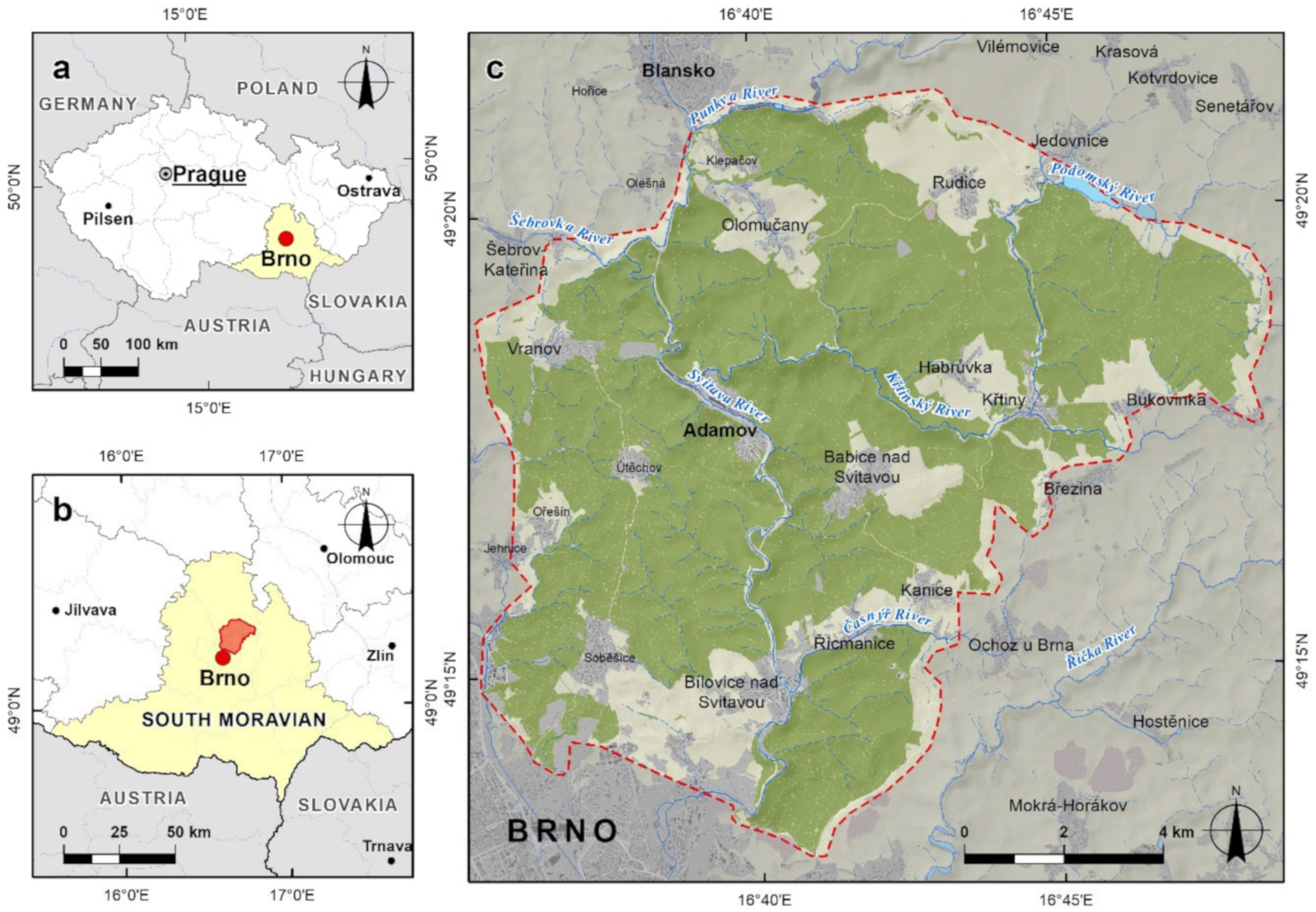

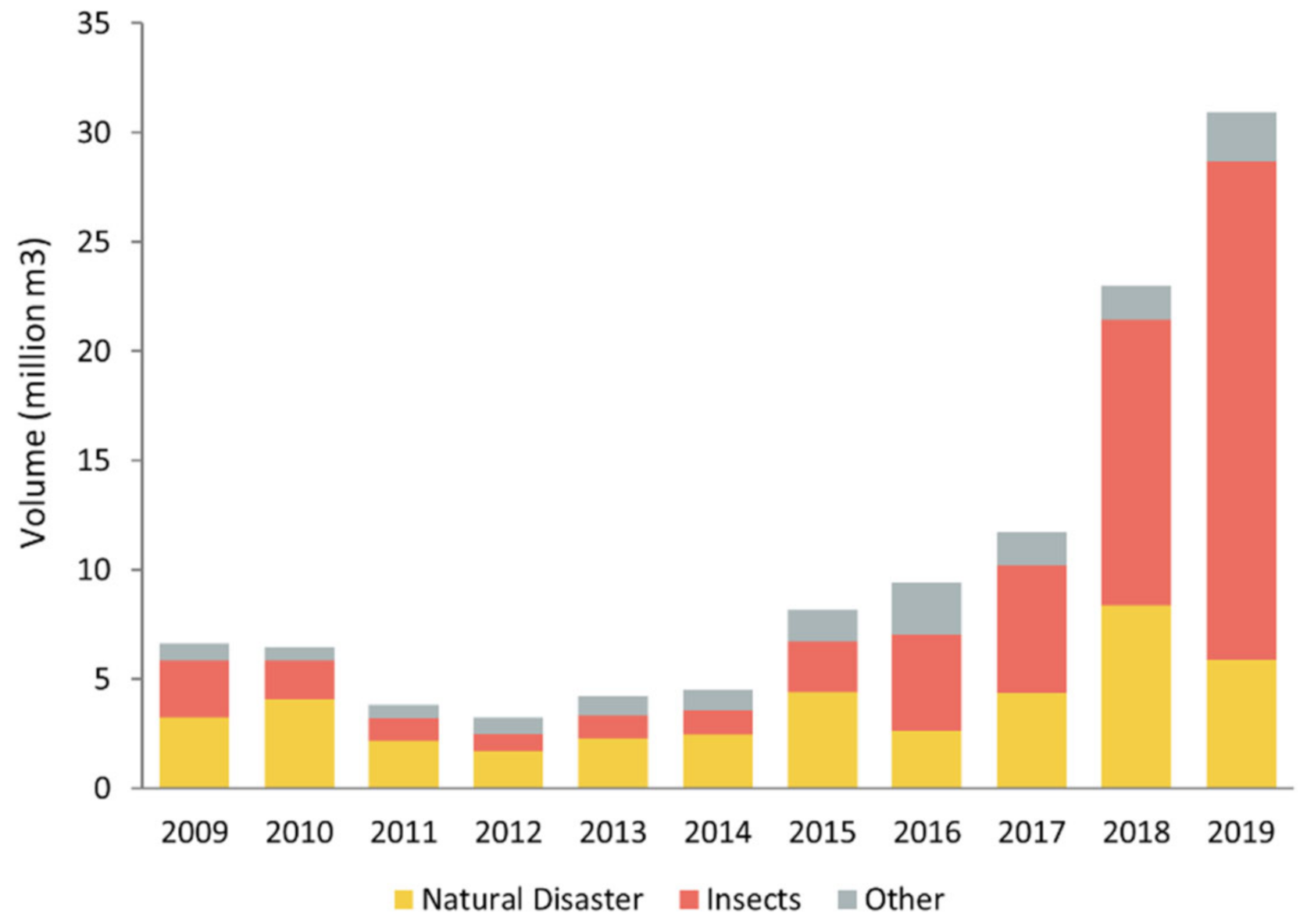
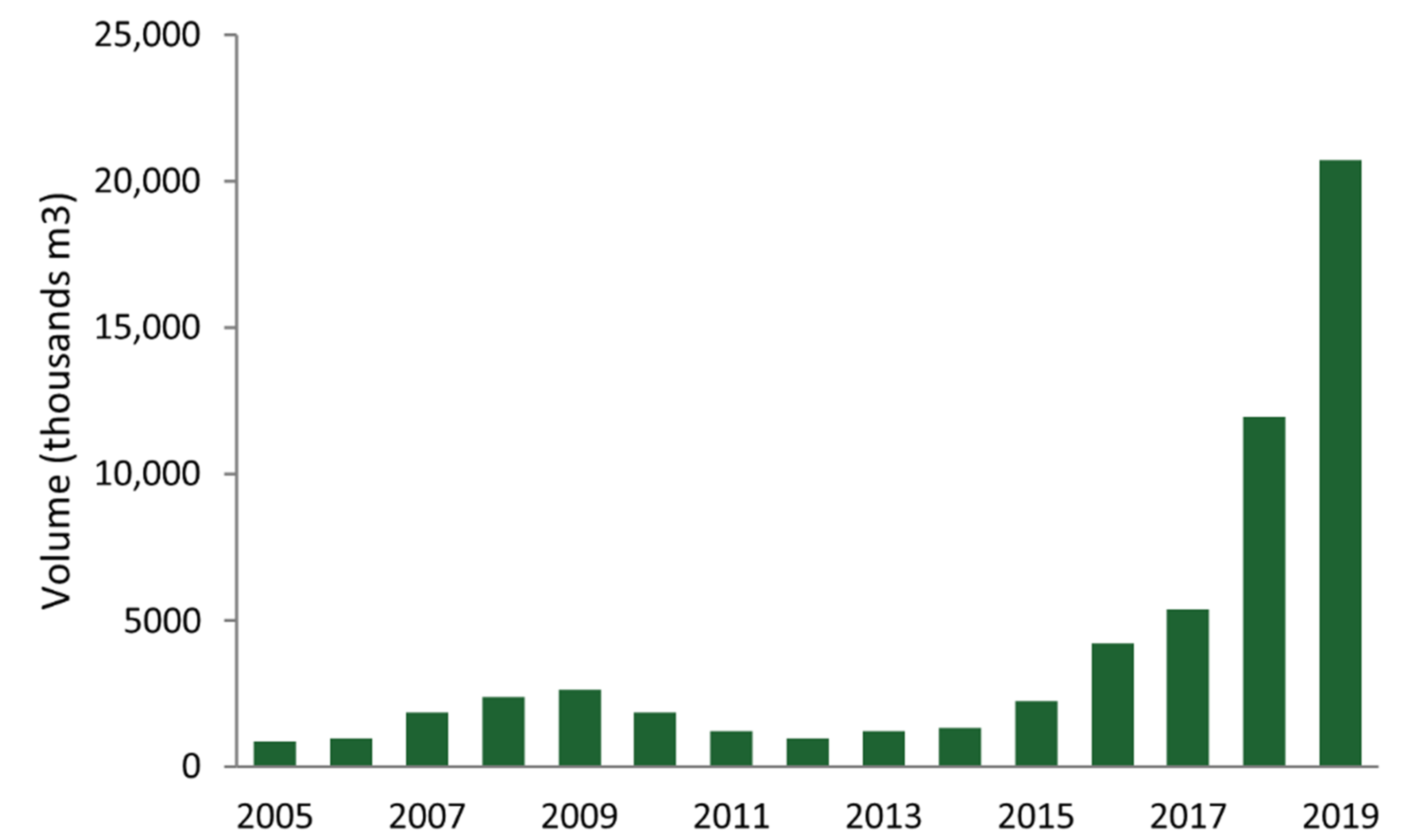

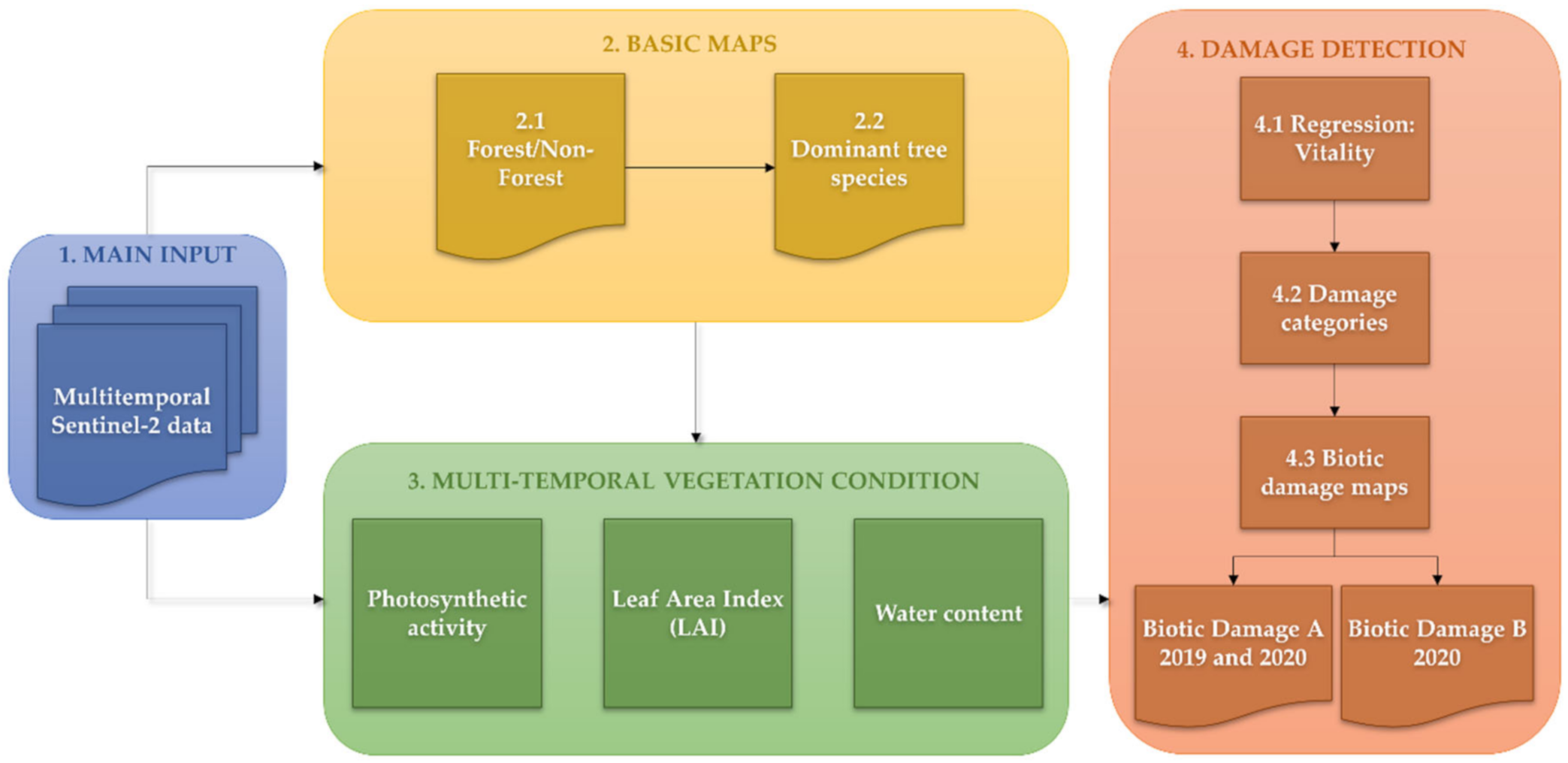

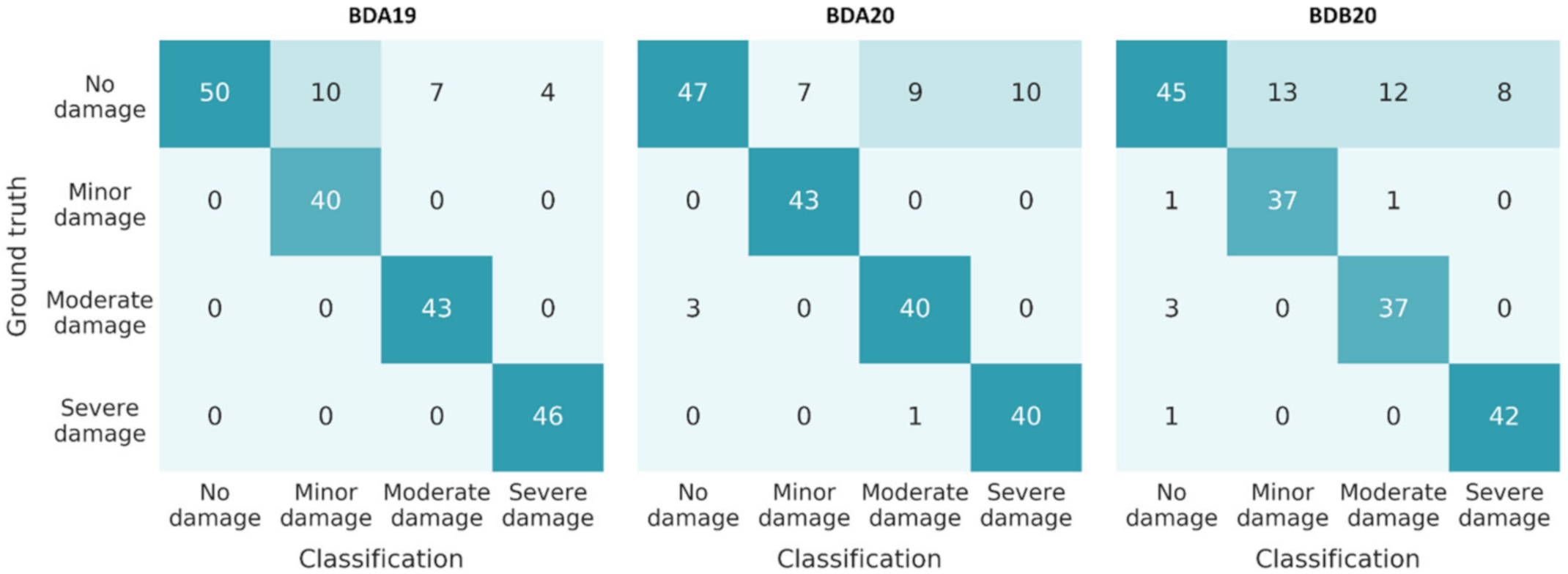
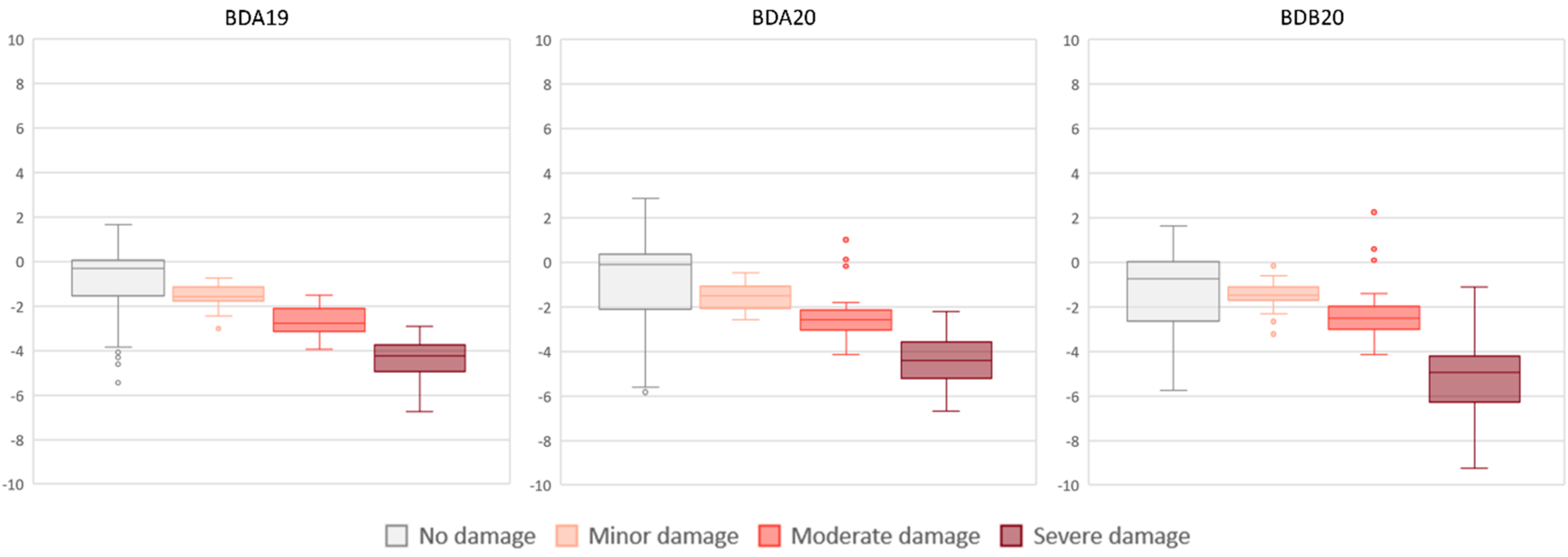
| Species | 2018 | 2019 | 2020 | Total |
|---|---|---|---|---|
| Picea abies | 30,564 | 59,958 | 33,897 | 124,419 |
| Pinus sylvestris | 2187 | 6735 | 4671 | 13,594 |
| Larix decidua | 4212 | 5711 | 1608 | 11,531 |
| Fagus sylvatica | 846 | 5167 | 1440 | 7452 |
| Abies alba | 1153 | 2563 | 503 | 4220 |
| Quercus petraea | 296 | 1020 | 471 | 1786 |
| Fraxinus excelsior | 93 | 377 | 473 | 943 |
| Pseudotsuga menziesii | 184 | 262 | 98 | 543 |
| Abies grandis | 35 | 191 | 8 | 234 |
| Quercus robus | 33 | 150 | 21 | 204 |
| Carpinus betulus | 64 | 116 | 23 | 203 |
| Other | 258 | 369 | 71 | 698 |
| Total | 39,925 | 82,619 | 43,284 | 165,828 |
| Product | Timing | Forest/Non-Forest | Dominant Species | Biotic Damage |
|---|---|---|---|---|
| Biotic damage A 2019 | t0 | 2018-03-22 | 2018-03-22 | 2018-09-10 |
| t1 | 2018-08-29 | 2018-08-29 | 2019-06-30 | |
| Biotic damage A 2020 | t0 | 2019-04-01 | 2019-04-01 | 2019-06-30 |
| t1 | 2019-06-30 | 2019-06-30 | 2020-07-01 | |
| Biotic damage B 2020 | t0 | 2020-04-02 | 2020-04-02 | 2019-06-30 |
| t1 | 2020-07-01 | 2020-07-01 | 2020-07-01 |
| Sentinel-2 Bands | Central Wavelength (nm) * | Spatial Resolution (m) |
|---|---|---|
| Band 01-Coastal aerosol | 442.7 | 60 |
| Band 02-Blue | 492.4 | 10 |
| Band 03-Green | 559.8 | 10 |
| Band 04-Red | 664.6 | 10 |
| Band 05-Red Edge 1 | 704.1 | 20 |
| Band 06-Red Edge 2 | 740.5 | 20 |
| Band 07-Red Edge 3 | 782.8 | 20 |
| Band 08-NIR | 832.8 | 10 |
| Band 8A-Narrow NIR | 864.7 | 20 |
| Band 09-Water vapour | 945.1 | 60 |
| Band 10-Cirrus | 1373.5 | 60 |
| Band 11-SWIR 1 | 1613.7 | 20 |
| Band 12-SWIR 2 | 2202.4 | 20 |
| Product | Class | acc. | prec. | rec. | F1 | CE | OE | relB |
|---|---|---|---|---|---|---|---|---|
| BDA19 | No damage | 0.90 | 1.00 | 0.70 | 0.83 | 0.00 | 0.30 | 0.42 |
| Minor damage | 0.95 | 0.80 | 1.00 | 0.89 | 0.20 | 0.00 | −0.20 | |
| Moderate damage | 0.97 | 0.86 | 1.00 | 0.93 | 0.14 | 0.00 | −0.14 | |
| Severe damage | 0.98 | 0.92 | 1.00 | 0.96 | 0.08 | 0.00 | −0.08 | |
| BDA20 | No damage | 0.86 | 0.94 | 0.64 | 0.76 | 0.06 | 0.36 | 0.46 |
| Minor damage | 0.97 | 0.86 | 1.00 | 0.93 | 0.14 | 0.00 | −0.14 | |
| Moderate damage | 0.94 | 0.80 | 0.93 | 0.86 | 0.20 | 0.07 | −0.14 | |
| Severe damage | 0.95 | 0.80 | 0.98 | 0.88 | 0.20 | 0.02 | −0.18 | |
| BDB20 | No damage | 0.81 | 0.90 | 0.58 | 0.70 | 0.10 | 0.42 | 0.56 |
| Minor damage | 0.93 | 0.74 | 0.95 | 0.83 | 0.26 | 0.05 | −0.22 | |
| Moderate damage | 0.92 | 0.74 | 0.93 | 0.82 | 0.26 | 0.08 | −0.20 | |
| Severe damage | 0.96 | 0.84 | 0.98 | 0.90 | 0.16 | 0.02 | −0.14 |
Publisher’s Note: MDPI stays neutral with regard to jurisdictional claims in published maps and institutional affiliations. |
© 2020 by the authors. Licensee MDPI, Basel, Switzerland. This article is an open access article distributed under the terms and conditions of the Creative Commons Attribution (CC BY) license (http://creativecommons.org/licenses/by/4.0/).
Share and Cite
Fernandez-Carrillo, A.; Patočka, Z.; Dobrovolný, L.; Franco-Nieto, A.; Revilla-Romero, B. Monitoring Bark Beetle Forest Damage in Central Europe. A Remote Sensing Approach Validated with Field Data. Remote Sens. 2020, 12, 3634. https://doi.org/10.3390/rs12213634
Fernandez-Carrillo A, Patočka Z, Dobrovolný L, Franco-Nieto A, Revilla-Romero B. Monitoring Bark Beetle Forest Damage in Central Europe. A Remote Sensing Approach Validated with Field Data. Remote Sensing. 2020; 12(21):3634. https://doi.org/10.3390/rs12213634
Chicago/Turabian StyleFernandez-Carrillo, Angel, Zdeněk Patočka, Lumír Dobrovolný, Antonio Franco-Nieto, and Beatriz Revilla-Romero. 2020. "Monitoring Bark Beetle Forest Damage in Central Europe. A Remote Sensing Approach Validated with Field Data" Remote Sensing 12, no. 21: 3634. https://doi.org/10.3390/rs12213634
APA StyleFernandez-Carrillo, A., Patočka, Z., Dobrovolný, L., Franco-Nieto, A., & Revilla-Romero, B. (2020). Monitoring Bark Beetle Forest Damage in Central Europe. A Remote Sensing Approach Validated with Field Data. Remote Sensing, 12(21), 3634. https://doi.org/10.3390/rs12213634







